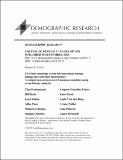Files in this item
Co-ethnic marriage versus intermarriage among immigrants and their descendants : a comparison across seven European countries using event-history analysis
Item metadata
| dc.contributor.author | Hannemann, Tina | |
| dc.contributor.author | Kulu, Hill | |
| dc.contributor.author | Rahnu, Leen | |
| dc.contributor.author | Puur, Allan | |
| dc.contributor.author | Hărăguș, Mihaela | |
| dc.contributor.author | Obućina, Ognjen | |
| dc.contributor.author | González Ferrer, Amparo | |
| dc.contributor.author | Neels, Karel | |
| dc.contributor.author | Van den Berg, Layla | |
| dc.contributor.author | Pailhé, Ariane | |
| dc.contributor.author | Potârcă, Gina | |
| dc.contributor.author | Bernardi, Laura | |
| dc.date.accessioned | 2018-09-18T14:30:10Z | |
| dc.date.available | 2018-09-18T14:30:10Z | |
| dc.date.issued | 2018-09-18 | |
| dc.identifier | 253407605 | |
| dc.identifier | 1912d301-c271-4cf0-8456-52b90d1b2ea3 | |
| dc.identifier | 85055628031 | |
| dc.identifier | 000444735100001 | |
| dc.identifier.citation | Hannemann , T , Kulu , H , Rahnu , L , Puur , A , Hărăguș , M , Obućina , O , González Ferrer , A , Neels , K , Van den Berg , L , Pailhé , A , Potârcă , G & Bernardi , L 2018 , ' Co-ethnic marriage versus intermarriage among immigrants and their descendants : a comparison across seven European countries using event-history analysis ' , Demographic Research , vol. 39 , 17 , pp. 487-524 . https://doi.org/10.4054/DemRes.2018.39.17 | en |
| dc.identifier.issn | 1435-9871 | |
| dc.identifier.other | ORCID: /0000-0001-8808-0719/work/75997001 | |
| dc.identifier.uri | https://hdl.handle.net/10023/16045 | |
| dc.description | The research leading to these results has received funding from the European Union's Seventh Framework Programme (FP7/2007-2013) under grant agreement no. 320116 for the research project FamiliesAndSocieties. | en |
| dc.description.abstract | BACKGROUND Immigrants and their descendants often marry a co-ethnic partner despite the abundance of native-born marriage candidates. The prevalence of co-ethnic marriages and intermarriage among migrants is influenced by their integration level and cultural background as much as individual preferences and structural factors. OBJECTIVE This paper expands existing literature on intermarriage by analysing first marriages across European countries, distinguishing marriage type (endogamous versus exogamous) and migrant generations (immigrants versus their descendants). METHODS Data from seven countries was aggregated using the count-data method and was subsequently pooled and analysed together; first, to estimate unadjusted first marriage rates; second, to calculate marriage risks separately by marriage type; and, finally, to directly compare the risk of exogamous and endogamous marriage. RESULTS There are substantial differences in the prevalence of co-ethnic marriage and intermarriage across the migrant groups. Migrants from non-EU countries often show a high prevalence of co-ethnic marriages and a low risk of intermarriage, whereas migrants from neighbouring countries show a relatively high risk of intermarriage. CONCLUSIONS Ethnic background and early socialisation have strong impacts on the partner choice of migrants and their descendants. The results suggest a strong influence of minority subcultures for some migrant groups, but also intergenerational adaptation processes for others. | |
| dc.format.extent | 1524772 | |
| dc.language.iso | eng | |
| dc.relation.ispartof | Demographic Research | en |
| dc.subject | Marriage | en |
| dc.subject | Migrants | en |
| dc.subject | Second generation | en |
| dc.subject | Comparative studies | en |
| dc.subject | Europe | en |
| dc.subject | HQ The family. Marriage. Woman | en |
| dc.subject | 3rd-DAS | en |
| dc.subject.lcc | HQ | en |
| dc.title | Co-ethnic marriage versus intermarriage among immigrants and their descendants : a comparison across seven European countries using event-history analysis | en |
| dc.type | Journal article | en |
| dc.contributor.institution | University of St Andrews. School of Geography & Sustainable Development | en |
| dc.identifier.doi | https://doi.org/10.4054/DemRes.2018.39.17 | |
| dc.description.status | Peer reviewed | en |
This item appears in the following Collection(s)
Items in the St Andrews Research Repository are protected by copyright, with all rights reserved, unless otherwise indicated.

